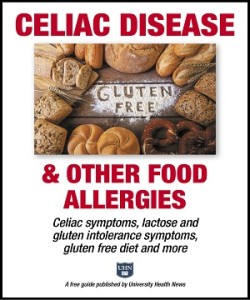Symptoms of Celiac Disease: The Unpredictable Effects of Gluten
Over a lifespan, symptoms of celiac disease tend to shift from the classic gastrointestinal symptoms in childhood—diarrhea, bloating, pain—to “non-classical” or “subclinical” celiac symptoms in adults, such as fatigue, anemia, arthritis, and numbness or tingling in the fingers and toes.
Non-classical symptoms can make celiac disease harder to spot, particularly if a patient has other medical conditions with similar symptoms.
In addition, symptoms of celiac disease vary widely from person to person. And some people with celiac disease have no symptoms, but they still can develop complications of the disease over time.
Celiacs are more likely to be susceptible to problems relating to inflammation, malabsorption, and malnutrition; these include osteoporosis, defects in tooth enamel, central and peripheral nervous system disease, pancreatic disease, internal hemorrhaging, organ disorders (gall bladder, liver, and spleen) and gynecological disorders, including infertility.
Untreated celiac disease also has been linked to an increased risk of certain types of cancer, particularly intestinal lymphoma and bowel cancer.
Start Feeling Better!
Download this expert FREE guide, Celiac Disease & Other Food Allergies: Celiac symptoms, lactose and gluten intolerance symptoms, gluten-free diet, and more.
Learn the facts about celiac symptoms, lactose and gluten intolerance symptoms and how you can go gluten-free happily, healthfully and confidently!
The Mechanics of Celiac Disease
Celiac disease is a gastrointestinal disorder characterized by intolerance to gluten, a protein found in wheat, rye, and barley. When a person with celiac disease consumes gluten in any form. (And there are many forms—in packaged foods, in over-the-counter vitamins, in supplements, even in cosmetics.) The immune system responds by damaging the villi, tiny fibers in the intestinal wall that help absorb nutrients from food, including essential vitamins, minerals, and other nutrients.
Undetected celiac disease can lead to greater problems, such as anemia, osteoporosis, fatigue, concentration problems, hair loss, mouth ulcers, skin lesions and itchiness, and tingling and numbness in the hands and feet. Most celiac patients initially will have lactose intolerance, and about 15 to 20 percent have depression. Many with active celiac disease have decreased spleen function, making them more susceptible to infections such as pneumonia.
Older Adults and Celiac Disease
New studies suggest it’s possible to develop celiac disease quite late in life. Still unanswered is the question as to how and why a person would develop celiac disease at age 60, 70, 80, or even 90. There are theories on what may trigger celiac, like changes in the intestinal bacteria, but these theories are not yet proven.
While younger patients are often able to heal quickly on a gluten-free diet, intestinal healing may take longer for older adults. The dramatic turnarounds in health sometimes seen after diagnosis and adherence to the gluten-free diet—feeling like a new person overnight—aren’t typical for those diagnosed at an older age; some may never get fully back to normal.
Since older adults may have incomplete healing, physicians recommend that they regularly check vitamin and mineral levels—especially iron, zinc, vitamin B12, and vitamin D, which are commonly malabsorbed.
One recent study suggests that celiac disease is four times greater in the United States today than it was in the 1950s. Researchers can’t pinpoint the reasons behind this upswing in celiac disease, but many believe a combination of genetic and environmental factors are to blame. About 30 percent of people have the genes that predispose them to celiac disease, and celiac patients are more likely to have a sibling, child, or parent with the disease. So, diagnosing celiac disease may help prevent complications not only for yourself but also for a family member.
Not everyone with gluten-related symptoms has celiac disease. So a medical evaluation is essential to determine whether you have the disease. To diagnose, doctors use a blood test for gluten and can perform a biopsy of the small intestine to confirm the diagnosis.
What You Can Do
- Ask your doctor to be tested for celiac disease if you have gastrointestinal symptoms, such as frequent diarrhea and cramping or bloating.
- If you have the disease, consult a registered dietitian with an expertise in celiac disease to develop a well-varied, nutritious meal plan.
- Watch for hidden sources of gluten; gluten can be found in non-food items, including lipstick, toothpaste, the glue on stamps and envelopes, and even medications.
Originally published in May 2016 and updated.
The post Symptoms of Celiac Disease: The Unpredictable Effects of Gluten appeared first on University Health News.
Read Original Article: Symptoms of Celiac Disease: The Unpredictable Effects of Gluten »
Powered by WPeMatico


